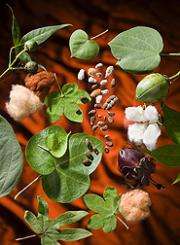ARS Plant Collections Help Safeguard Crops

(PhysOrg.com) -- In the months ahead, Agricultural Research Service (ARS) scientists plan to collect walnuts from Kyrgyzstan, grasses from Russia, and carrots and sunflowers from fields across the Southeastern United States in efforts that will enhance one of the nation's most effective tools for protecting the food supply.
Researchers will make the trips to collect plants with useful characteristics. The collected material will become part of the U.S. National Plant Germplasm System (NPGS), a network of gene banks that plays an integral role in preserving genetic traits that can be used to combat emerging pests, pathogens, diseases and other threats to the world's supply of food and fiber.
The NPGS collections are made up of approximately 511,000 samples of seeds, tissues and whole plants kept at more than 20 ARS gene banks around the country. Many of the gene banks also receive support from universities and state agricultural experiment stations.
ARS scientists use collection materials for research and mail out thousands of samples of materials free of charge each year to researchers and educators in the United States and countries throughout the world.
ARS also funds approximately 15 expeditions every year to search for new samples of crops and crop relatives with unique traits, such as drought tolerance and pest resistance. The trips, coordinated by the ARS National Germplasm Resources Lab (NGRL) in Beltsville, Md., are conducted with collaboration from host countries and include benefits for these countries.
Useful traits in the samples added to the NPGS may be incorporated into crop cultivars, often many years later. For example, a peanut found in a Brazilian market in 1952 is a source for resistance to a wilt virus for most of the peanuts grown in the Southeastern United States and in many other nations. A wheat plant collected in Turkey in 1948 effectively resisted a fungal pathogen that emerged as a major threat 15 years later. Its genetics are now incorporated into virtually every wheat variety grown in the Pacific Northwest.
Requests for material are filed through the Germplasm Resources Information Network (GRIN), an online database (www.ars-grin.gov) that identifies and keeps track of every sample in the collection.
Read more about this and other ARS collections in the January 2010 issue of Agricultural Research magazine.
Provided by USDA Agricultural Research Service





















